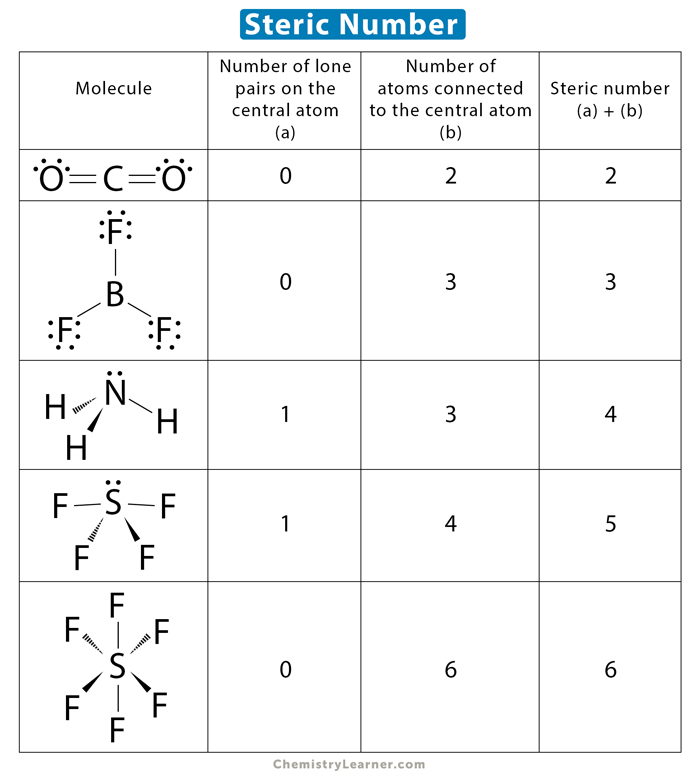Steric Number
The steric number is the number of atoms bonded to the central atom of a molecule plus the number of lone pairs of electrons on the central atom. In other words, the steric number tells us how many regions of electron density are present in a molecule. It is used in Valence Shell Electron Pair Repulsion (VSEPR) theory to determine the molecular geometry [1-4].
How to Calculate Steric Number
One must know the Lewis structure to determine the steric number. It is calculated by adding the number of lone pairs on the central atom and the number of atoms bonded to it [1].
Formula
Steric Number = (number of lone pairs on the central atom) + (number of atoms bonded to the central atom)
Another formula for calculating the steric number is
Steric number = ½ x [(number of valence electrons) + (number of monovalent atoms attached to the central atom) – (cationic charge) + (anionic charge)]
Examples [1-4]
- Carbon dioxide (CO2) – The carbon dioxide molecule consists of a central carbon atom surrounded by two oxygen atoms. Carbon shares a double bond with each oxygen atom. It does not have any lone pairs. The steric number is 0 + 2 = 2.
- Ammonia (NH3) – Ammonia consists of a central nitrogen atom surrounded by three hydrogen atoms. It has three N-H single bonds and a lone pair on nitrogen. The steric number is 1 + 3 = 4.
- Water (H2O) – Water has a central oxygen atom surrounded by two hydrogen atoms. Oxygen and hydrogen combine to form two O-H single bonds. There are two lone pairs on oxygen. The steric number is 2 + 2 = 4.
- Sulfur dioxide (SO2) – Sulfur dioxide has a central sulfur atom bonded to two oxygen atoms by double bonds. There is a lone pair on sulfur. The steric number is 1 + 2 = 3.
- Hydrogen cyanide (HCN) – Hydrogen cyanide has a central carbon atom. On it either side, there is one hydrogen and one nitrogen atom. Carbon shares a single bond with hydrogen and a triple bond with nitrogen. It does not have any lone pairs. The steric number is 0 + 2 = 2.
- Methane (CH4) – Methane has a central carbon atom surrounded by four hydrogen atoms. There are four C-H single bonds with no lone pairs. The steric number is 0 + 4 = 4.
- Boron trifluoride (BF3) – Boron trifluoride consists of a central boron atom surrounded by three fluorine atoms. Each fluorine atom makes a single bond with boron, which has no lone pairs. The steric number is 0 + 3 = 3.
- Sulfur hexafluoride (SF6) – Sulfur hexafluoride comprises a central sulfur atom surrounded by six fluorine atoms. The expanded octet of sulfur can accommodate up to 12 electrons in its valence shell. There are six S-F single bonds with no lone pair. The steric number is 0 + 6 = 6.
Steric Number and Molecular Geometry
According to VSEPR theory, the electrons in the valence shell rearrange to minimize the repulsion among the electron pairs and maximize the distance. Under such conditions, the molecule’s energy is at its lowest, resulting in increased stability. Aside, the steric number determines the molecule’s shape, as shown in the following chart [1,2].
| Steric Number | Number of lone pairs | Number of bond pairs | Molecular geometry |
|---|---|---|---|
| 2 | 2 | 0 | Linear |
| 3 | 3 | 0 | Trigonal planar |
| 3 | 2 | 1 | Angular or bent |
| 4 | 4 | 0 | Tetrahedral |
| 4 | 3 | 1 | Trigonal pyramidal |
| 4 | 2 | 2 | Angular or bent |
| 5 | 5 | 0 | Trigonal bipyramidal |
| 5 | 4 | 1 | Seesaw |
| 5 | 3 | 2 | T-shaped |
| 5 | 2 | 3 | Linear |
| 6 | 6 | 0 | Octahedral |
| 6 | 5 | 1 | Square pyramidal |
| 6 | 4 | 2 | Square planar |





